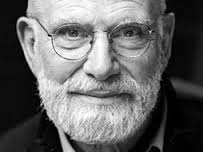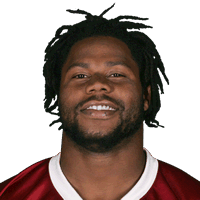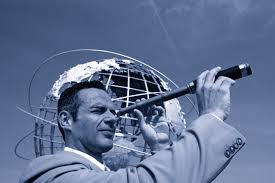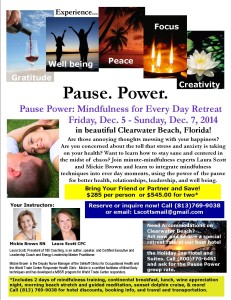Your turn!
A salon for change, challenge, and empowered living.
What Do Coaches Do?

At a recent Central Florida chapter meeting of the International Coaches Federation, our table topic question was, “How do you clearly and succinctly describe what you do, so that others fully understand what coaching is?”
The coaches in the room were a diverse group of life or wellness coaches, executive and leadership coaches, business coaches, and career coaches and the responses to this question were similarly diverse, as each type of coach serves their clients in different ways. Here’s a summary of the responses to the question “What do coaches do?”
In general, coaches can help us:
• connect the dots
• be our authentic selves
• take us from good to great
• create a personal brand
• come to the right table
• discover what we really want in life
• find the answers from within ourselves
• get us from where we are, to where we want to be
• be more accountable to ourselves and others
• formulate goals aligned with values
• play nice in the sandbox
The second question we addressed was “What are the most significant barriers that we, as individual coaches, face in educating the general public about the profession of coaching?”
We agreed that the biggest barrier was a lack of education around what coaching really is. A number of coaches recalled clients who had confused psychotherapy or counseling with coaching. Some clients ask for a coach but they really want a consultant — someone to tell them what to do.
Also, in some corporate environments, coaching is perceived as punitive; the perception being that if you’re assigned a coach this is your last chance to clean up your act before they show you the door. However the reality is quite the opposite as the majority of companies utilize coaching to develop their high potential leaders to ready them for the next level of leadership, and to help supervisors and executives develop customized professional leadership plans and to help them achieve their developmental goals.
In my personal experience as an executive coach, I find my clients truly value the confidential space that the professional coach creates and honors. They also appreciate an objective sounding board and the empowering questions that lead them to greater insights into what they really want to achieve, and why. The goal is often to help the client achieve intrinsic motivation vs. external motivation, so that the energy for change or develop comes from the clients’ genuine desire for continuous improvement and well-being.
If you engage with a coach and they start telling you what you need to do, move on. That person is not a coach. The ICF definition coaching is: Partnering with clients in a thought-provoking and creative process that inspires them to maximize their personal and professional potential.
Through extensive training, certified coaches are trained to listen, to observe and to customize their approach to individual client needs. Unlike most other forms of personal development, coaches seek to elicit solutions and strategies from the client.
The underlying belief is that the client is whole, naturally creative and resourceful.
Accessing your “Mad Genius”
 Recently, I was on the phone, doing a debrief on an Energy Leadership assessment and asked the respondent how she was expressing her Level 6 energy–the energy of genius thinking and the creative flow state. She responded, “I know intuitively what to do and say, like I am psychic. I am using my intuition but I know I am right.”
Recently, I was on the phone, doing a debrief on an Energy Leadership assessment and asked the respondent how she was expressing her Level 6 energy–the energy of genius thinking and the creative flow state. She responded, “I know intuitively what to do and say, like I am psychic. I am using my intuition but I know I am right.”
After our call, I reflected on what she had said and recalled the times when I was able to totally trust my intuition and access my “mad genius.” You likely have had this experience: You are alone with your thoughts, perhaps on a walk, or in the shower, or leaning back in your chair with your eyes closed, puzzling out a problem, and BAM! a flash of insight comes to you, or a ridiculously perfect idea, and a smile plays on your lips and you feel an immediate need to act or decide, Damn the naysayers!
In this state you feel joy and synergy. You may be getting goose bumps, a tingling sensation, or feeling like there’s butterflies in your stomach. But strangely, NO FEAR!
There is no wrong decision at Level Six because the journey is more important than the destination; everything is happening for a reason; you are accessing wisdom you never even knew you had. You are giddy with excitement!
If this state is something you can only dream about, allow me to make some suggestions on how you might access this level six energy and tap into the mad genius state.
1) Suspend judgment and just ask “What if…?”
2) Breathe into the “What if?” question and wait for a moment
3) Imagine one perfect scenario and then another, and another
4) Smile and open your palms as if you are getting ready to accept a gift of precious gems or gold coins
5) Acknowledge that there are no mistakes
6) Invite the mad genius into your world and collaborate with him, and play and laugh
Intentional Leadership
I was speaking to a colleague about how leaders come to feel the gap between where they are and where they want to be in terms of leadership.
They can usually point to one or two incidents when they were not at their best or things got a bit out of control and the outcome was short of what they hoped.
Self-aware leaders will take some responsibility for the less-than-ideal outcome. They will reflect on what happened and perhaps identify the point when the train started to go off the rails. They said something or did something, people reacted in unexpected ways, the morale or the mood shifted, and suddenly a well-planned engagement or meeting took a turn for the worse.
The reflection is important. That’s how adults learn and grow. But the next step is harder. How do you repair the damage? How do you ensure that it doesn’t happen again?
Repairing the damage may be as simple as a public apology. I know, it’s harder than it sounds. How do you ensure it doesn’t happen again? You can’t. We are human. We make mistakes. But we can make less of them if we are self aware and intentional and strategic about how we show up as leaders.
How do you do that?
It starts with a personal leadership inventory. An inventory that includes your vision of an ideal leadership style that reflects your values and personality and then identifies the blocks to achieving that ideal more consistently. That means having a greater degree of awareness around:
-Your triggers and hot buttons
-Your values and how you typically express them
-The quality of the energy you bring to a space
-The most effective way to earn trust in your organization
This awareness exposes where we might be vulnerable, how we can stand strong and be authentic as leaders, and it informs our choices around how we respond and how we engage positively.
It won’t guarantee that we will never again go off the rails but it will ensure that there is an engaged and conscious decision-maker at the wheel when things don’t go exactly as planned.
Learn how to craft your personal Leadership Inventory by joining us at the Emerging Leaders Development Seminar at the University of Tampa Saturday October 10, 2015. The public is welcome!
http://www.eventbrite.com/e/emerging-leaders-development-seminar-oct-10-tickets-18153006130
The Gift of Anger and Sadness
 As an executive coach, I help my clients deal with some pretty highly-charged emotional states. And during those times I invite my clients to suspend judgment around certain emotions that they think of as “bad.” Sometimes my clients feel compelled to apologize for emotions like anger and sadness. They want to quickly move through these emotional states, deeming them unproductive or negative.
As an executive coach, I help my clients deal with some pretty highly-charged emotional states. And during those times I invite my clients to suspend judgment around certain emotions that they think of as “bad.” Sometimes my clients feel compelled to apologize for emotions like anger and sadness. They want to quickly move through these emotional states, deeming them unproductive or negative.
It’s true that my job as a coach is to help my clients become “unstuck” and move forward productively and strategically. However I can’t help but see the gift that our emotions bring. With awareness and with empathy we can actually learn how to use our emotions to be more authentic as leaders and to connect and engage with others more effectively.
I won’t belabor you with stats and scientific studies that back this up, but trust me they’re out there. If you want to skip the scientific literature and experience this for yourself, I invite you to see the recent Pixar movie “Inside out.” When Pixar was in development with this film, Pete Docter, the writer and director of the film, consulted with two emotion experts, University of California psychologists Dacher Keltner and Paul Ekman, to understand how the emotions of the 11-year-old character would impact her experience and her relationships, as her family made a disruptive cross-country move.
This is what Keltner and Ekman shared with Pete Docter about the science of emotions, as summarized in their NY Times article titled “The Science of ‘Inside Out'”:
“Emotions organize — rather than disrupt — our social lives. Studies have found, for example, that emotions structure (not just color) such disparate social interactions as attachment between parents and children, sibling conflicts, flirtations between young courters and negotiations between rivals.
Other studies find that it is anger (more so than a sense of political identity) that moves social collectives to protest and remedy injustice. Research that one of us has conducted has found that expressions of embarrassment trigger others to forgive when we’ve acted in ways that momentarily violate social norms.
This insight, too, is dramatized in the movie. You might be inclined to think of sadness as a state defined by inaction and passivity — the absence of any purposeful action. But in “Inside Out,” as in real life, sadness prompts people to unite in response to loss.”
When I work with clients on emotional self-mastery and resilience, we intentionally suspend judgment around the emotion and simply look at emotions as benign signals; signals that prompt us to be empathetic observers and strategic decision-makers around how we want to show up, or engage, in response to that emotion.
As the studies show, emotions can serve to unite us in empathy or in actions towards justice. In fact, all altruistic actions are birthed by our emotions, including anger at the injustice we see in our world.
So the next time you find yourself in a highly-charged emotional state, don’t judge yourself or the emotion. Instead, see this as the opportunity it is; an opportunity to use this emotion as the fire that forges the metal. And you are the blacksmith in the process a creating the person, or the leader, you want to be.
Hitting a wall? Check your mindset!
 Jeff Haden, a Contributing Editor for Inc. Magazine, recently posted a piece on the link between mindset and success and why those who have a growth mindset experience more success over the course of their lives than those who operate from a fixed mindset.
Jeff Haden, a Contributing Editor for Inc. Magazine, recently posted a piece on the link between mindset and success and why those who have a growth mindset experience more success over the course of their lives than those who operate from a fixed mindset.
He cites Dr. Carol Dweck’s work at Stanford, documented in her book, Mindset: The New Psychology of Success:
The first step to getting the things you want is to believe you deserve them.
Far from a trivial platitude, this sort of thinking actually closely mirrors what modern psychology depicts in how our beliefs influence our behavior.Dr. Dweck’s studies posit that there are two basic mindsets that control how most people see themselves.
Those with a “fixed mindset” assume intelligence, character, and creative potential are unchangeable attributes writ in stone since birth — that they cannot be modified in any meaningful way.They further assume that success is simply a result of this inherent talent, and as a result, they often avoid failure in order to maintain an aura of infallibility.
Those with a “growth mindset” have a much more malleable view on success. They do not view failure as a reflection of their ability, but rather as a starting point for experimentation and testing of ideas.
As I read about Dr Dweck’s work, I noted that the mindsets differ markedly in the core beliefs around intelligence. People who have a fixed mindset believe that “Intelligence is static.” Those with growth mindsets believe “Intelligence can be developed” and they act accordingly: embracing challenges, being persistence in the face of obstacles, and being motivated and inspired by their own accumulation of knowledge and the helpful critiques and guidance from others.
I agree with Haden that the growth mindset is something that can be developed by practice and by consistently acknowledging and celebrating the small successes. He recommends that we “focus on creating small wins through changing your habits. Make daily ‘micro quotas’ (10 minutes of working out a day) that are so easy you can’t say no. In short, nail it then scale it.”
As a coach, I see self confidence increase when clients begin to attribute their success to their choices and efforts, rather than their IQ or education. A grow mindset is not something you are born with; a growth mindset is developed by intent and by the adoption of new ways of thinking or being, and is supported by natural curiosity, internal definitions of success, and aligning your pursuits with your passions and values.
The Power of the Pause–Just Breathe
I absolutely love this short video on the power of the breath on our emotional state!
The way these young children describe how strong emotions mess with their happiness is both sad and touching but it’s delightful to see how they are using what they know about their brains and how they are using simple mindfulness techniques, like breath work, to manage their emotions and their stress response.
Mickie Brown and I will be teaching these techniques at the Pause Power workshop on May 2, 2015 in Bradenton, Florida and we invite you to join us. Click here for more information.
Oliver Sacks Faces Death with the Power of Detachment
 In his opinion piece in the New York Times, Oliver Sacks, a professor of neurology at the New York University School of Medicine, announced to the world that he is dying of terminal cancer and shared with us how he spending the last of his days. I was impressed by how he is able to grasp the deep power of strategic detachment and be so intentionally in the moment.
In his opinion piece in the New York Times, Oliver Sacks, a professor of neurology at the New York University School of Medicine, announced to the world that he is dying of terminal cancer and shared with us how he spending the last of his days. I was impressed by how he is able to grasp the deep power of strategic detachment and be so intentionally in the moment.
Here is an excerpt:
“I feel intensely alive, and I want and hope in the time that remains to deepen my friendships, to say farewell to those I love, to write more, to travel if I have the strength, to achieve new levels of understanding and insight.
This will involve audacity, clarity and plain speaking; trying to straighten my accounts with the world. But there will be time, too, for some fun (and even some silliness, as well).
I feel a sudden clear focus and perspective. There is no time for anything inessential. I must focus on myself, my work and my friends. I shall no longer look at “NewsHour” every night. I shall no longer pay any attention to politics or arguments about global warming.
This is not indifference but detachment — I still care deeply about the Middle East, about global warming, about growing inequality, but these are no longer my business; they belong to the future. I rejoice when I meet gifted young people — even the one who biopsied and diagnosed my metastases. I feel the future is in good hands.”
Don’t Quit Your Day Job!
 When I coach around careers, my clients are, understandably, anxious to move on to the next bright, shiny thing. However, as an entrepreneur who has founded three businesses, I know that it takes any where from two to five years to build a business. And even if you are being head hunted for a new position, you still want to remain fully engaged in your current role so you don’t burn a bridge or jeopardize the recommendation from a current colleague or boss that gets you the next great opportunity.
When I coach around careers, my clients are, understandably, anxious to move on to the next bright, shiny thing. However, as an entrepreneur who has founded three businesses, I know that it takes any where from two to five years to build a business. And even if you are being head hunted for a new position, you still want to remain fully engaged in your current role so you don’t burn a bridge or jeopardize the recommendation from a current colleague or boss that gets you the next great opportunity.
Landon Cohen knows this. He’s a entrepreneur running a valet business in South Carolina. He’s also a NFL football player. He’s a great example of my favorite saying:
“It’s not either, or….it’s and.”
Here’s an excerpt illustrating this from an article about Cohen in Yahoo Sports:
“Yes, sometimes Landon Cohen parks cars. And sometimes he plays in the NFL.
Cohen, amazingly, did both this month. And now he’s one win from parallel parking a Super Bowl ring between his knuckles.
As most fantasies go, Cohen’s January has been the definition of awesome. Four weeks ago, he and two lifelong friends were running their valet service in Spartanburg, S.C. One workout and a few phone calls later, the journeyman defensive tackle landed with the Seattle Seahawks, despite not having been on an NFL roster the entire regular season.”
Many times we are living under the illusion that we must choose between this or that. More often than not we can do both and that doing both, to the best of our ability, is the wisest choice we can make.
Intentional Leadership: Wear your Values on your Sleeve
 When I begin a coaching relationship with both teams and individuals, I begin with a values clarification exercise. Why?
When I begin a coaching relationship with both teams and individuals, I begin with a values clarification exercise. Why?
Because people don’t follow the leader, they follow their values. The best leaders articulate their values and wear them on their sleeve; in fact, they live their values. Everyday. Even when it appears to “hurt” them financially, or make them more vulnerable.
I am sure you have seen this. A leader experiences a setback or a challenge and instead of pointing fingers, or covering up, or taking the easy way out she, or he, steps up and does the more difficult, brave thing. And what happens? People take notice of this exceptional response and this leader’s personal brand, or currency, is suddenly elevated.
This is values-based leadership.
Harry M. Jansen Kraemer Jr., author of From Values to Action: The Four Principles of Values-Based Leadership, cites 4 principals of values-based leadership in this book, which can form the basis of this type of leadership. Here’s how he describes them in an article he wrote for Forbes:
“Values to Action centers on what I call the four principles of values-based leadership. The first is self-reflection: You must have the ability to identify and reflect on what you stand for, what your values are, and what matters most to you. To be a values-based leader, you must be willing to look within yourself through regular self-reflection and strive for greater self-awareness. After all, if you aren’t self-reflective, how can you truly know yourself? If you don’t know yourself, how can you lead yourself? If you can’t lead yourself, how can you lead others?
The second principle is balance, which means the ability to see situations from multiple perspectives and differing viewpoints to gain a much fuller understanding. Balance means that you consider all sides and opinions with an open mind.
The third principle is true self-confidence, accepting yourself as you are. You recognize your strengths and your weaknesses and strive for continuous improvement. With true self-confidence you know that there will always be people who are more gifted, accomplished, successful and so on than you, but you’re OK with who you are.
The fourth principle is genuine humility. Never forget who you are or where you came from. Genuine humility keeps life in perspective, particularly as you experience success in your career. In addition, it helps you value each person you encounter and treat everyone respectfully.”
Perhaps you have had the privilege of working with a leader who demonstrated these principles. If so, you understand the positive effect these leaders can have on an organization. Perhaps you are that leader, or it is your intention be be that leader. If so, do so mindfully, intentionally, consistently, and people will take notice; you will earn their trust and they will, happily, follow your lead.
Pause. Power. Mindfulness for Every One.
Excited about our first Pause Power Retreat coming up in December in beautiful Clearwater Beach, Florida!

When I present programs on mindfulness, people always assume I mean meditation. Well, that’s one way to practice mindfulness but it’s not the only way. In fact, when my retreat partner Mickie Brown and I teach mindfulness to our clients we rarely suggest sitting meditation as the first option because we know it’s a hard habit to get get into and an even harder to maintain over time. Instead we teach breath work, walking meditation, and brain-based mindfulness techniques that can be easily integrated into every day life.
I practice mindfulness in the car, in the shower, and while I walk from place to place. I also use mindfulness techniques when I teach emotional intelligence or mastery, and conflict resiliency.
If there was just one habit I could point to that has made me more focused, peaceful, and happy, it would be my mindfulness practice. And no, I don’t meditate every day for 30 minutes; I meditate 30 times a day for 1 minute.
Are you with me?
If you want to learn how to do this, please consider joining us for the Pause Power Retreat. Come for the whole weekend or come for the day. December 5-7, 2014.
Click here for the flier and click here for the registration form. Email [email protected] for more information.
For professional coaches: 5.5 ICF CCEU’s available for this!!
